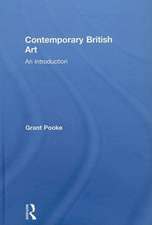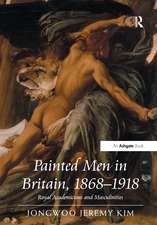Kyoto Visual Culture in the Early Edo and Meiji Periods: The arts of reinvention: Routledge Studies in the Modern History of Asia
Editat de Morgan Pitelka, Alice Y. Tsengen Limba Engleză Hardback – 12 mai 2016
Examining cultural production in the city of Kyoto in two periods of political transition, this book promises to be a major step forward in advancing our knowledge of Kyoto’s history and culture. Its chapters focus on two periods in Kyoto’s history in which the old capital was politically marginalized: the early Edo period, when the center of power shifted from the old imperial capital to the new warriors’ capital of Edo; and the Meiji period, when the imperial court itself was moved to the new modern center of Tokyo. The contributors argue that in both periods the response of Kyoto elites—emperors, courtiers, tea masters, municipal leaders, monks, and merchants—was artistic production and cultural revival.
As an artistic, cultural and historical study of Japan's most important historic city, this book will be invaluable to students and scholars of Japanese history, Asian history, the Edo and Meiji periods, art history, visual culture and cultural history.
| Toate formatele și edițiile | Preț | Express |
|---|---|---|
| Paperback (1) | 409.48 lei 6-8 săpt. | |
| Taylor & Francis – 10 ian 2019 | 409.48 lei 6-8 săpt. | |
| Hardback (1) | 1055.51 lei 6-8 săpt. | |
| Taylor & Francis – 12 mai 2016 | 1055.51 lei 6-8 săpt. |
Din seria Routledge Studies in the Modern History of Asia
-
 Preț: 326.40 lei
Preț: 326.40 lei -
 Preț: 311.41 lei
Preț: 311.41 lei -
 Preț: 317.76 lei
Preț: 317.76 lei -
 Preț: 310.95 lei
Preț: 310.95 lei -
 Preț: 311.91 lei
Preț: 311.91 lei - 9%
 Preț: 901.51 lei
Preț: 901.51 lei -
 Preț: 379.30 lei
Preț: 379.30 lei - 25%
 Preț: 711.72 lei
Preț: 711.72 lei - 18%
 Preț: 1278.70 lei
Preț: 1278.70 lei - 18%
 Preț: 948.84 lei
Preț: 948.84 lei - 18%
 Preț: 1055.21 lei
Preț: 1055.21 lei - 18%
 Preț: 1331.76 lei
Preț: 1331.76 lei - 18%
 Preț: 1003.30 lei
Preț: 1003.30 lei - 18%
 Preț: 1060.87 lei
Preț: 1060.87 lei -
 Preț: 424.87 lei
Preț: 424.87 lei -
 Preț: 485.94 lei
Preț: 485.94 lei - 18%
 Preț: 1004.86 lei
Preț: 1004.86 lei - 18%
 Preț: 1326.99 lei
Preț: 1326.99 lei - 18%
 Preț: 1060.87 lei
Preț: 1060.87 lei - 18%
 Preț: 1058.65 lei
Preț: 1058.65 lei -
 Preț: 441.80 lei
Preț: 441.80 lei - 28%
 Preț: 820.03 lei
Preț: 820.03 lei - 18%
 Preț: 1059.84 lei
Preț: 1059.84 lei - 28%
 Preț: 821.79 lei
Preț: 821.79 lei - 18%
 Preț: 1063.65 lei
Preț: 1063.65 lei - 18%
 Preț: 1059.84 lei
Preț: 1059.84 lei - 49%
 Preț: 218.36 lei
Preț: 218.36 lei - 18%
 Preț: 704.83 lei
Preț: 704.83 lei - 18%
 Preț: 1012.10 lei
Preț: 1012.10 lei - 25%
 Preț: 826.86 lei
Preț: 826.86 lei - 18%
 Preț: 1002.18 lei
Preț: 1002.18 lei - 15%
 Preț: 699.14 lei
Preț: 699.14 lei - 18%
 Preț: 1114.30 lei
Preț: 1114.30 lei - 27%
 Preț: 995.07 lei
Preț: 995.07 lei - 26%
 Preț: 765.01 lei
Preț: 765.01 lei - 18%
 Preț: 1059.84 lei
Preț: 1059.84 lei - 26%
 Preț: 821.94 lei
Preț: 821.94 lei - 18%
 Preț: 1056.00 lei
Preț: 1056.00 lei - 18%
 Preț: 1006.07 lei
Preț: 1006.07 lei -
 Preț: 488.71 lei
Preț: 488.71 lei - 18%
 Preț: 996.65 lei
Preț: 996.65 lei - 18%
 Preț: 1051.55 lei
Preț: 1051.55 lei - 18%
 Preț: 1065.78 lei
Preț: 1065.78 lei - 25%
 Preț: 769.10 lei
Preț: 769.10 lei - 18%
 Preț: 1054.43 lei
Preț: 1054.43 lei - 31%
 Preț: 765.01 lei
Preț: 765.01 lei - 18%
 Preț: 1009.21 lei
Preț: 1009.21 lei
Preț: 1055.51 lei
Preț vechi: 1287.22 lei
-18% Nou
Puncte Express: 1583
Preț estimativ în valută:
201.100€ • 210.11$ • 166.76£
201.100€ • 210.11$ • 166.76£
Carte tipărită la comandă
Livrare economică 12-26 aprilie
Preluare comenzi: 021 569.72.76
Specificații
ISBN-13: 9781138186613
ISBN-10: 1138186619
Pagini: 200
Ilustrații: 58
Dimensiuni: 156 x 234 x 18 mm
Greutate: 0.48 kg
Ediția:1
Editura: Taylor & Francis
Colecția Routledge
Seria Routledge Studies in the Modern History of Asia
Locul publicării:Oxford, United Kingdom
ISBN-10: 1138186619
Pagini: 200
Ilustrații: 58
Dimensiuni: 156 x 234 x 18 mm
Greutate: 0.48 kg
Ediția:1
Editura: Taylor & Francis
Colecția Routledge
Seria Routledge Studies in the Modern History of Asia
Locul publicării:Oxford, United Kingdom
Public țintă
Postgraduate and UndergraduateCuprins
1. Introduction Part I 2. Warriors in the Capital: Kobori Enshū and Kyoto Cultural Hybridity 3. From Kyoto to Edo and Back: Karasumaru Mitsuhiro as a Seventeenth-Century Diplomatic and Cultural Emissary 4. Subversive Shelf Decoration: The Princeton Sagamigawa Picture Scrolls Part II 5. Urban Parks and Imperial Memory: The Formation of Kyoto Imperial Garden and Okazaki Park as Sites of Cultural Revival 6. Rescuing Temples and Empowering Art: Naiki Jinzaburō and the Rise of Civic Initiatives in Meiji Kyoto 7. Naturalism Fusing Past and Present: The Reconfiguration of the Kyoto School of Painting and the Revival of the Textile Industry Epilogue 8. A Kyoto Garden Renewal? From Meiji to Early Showa Period
Notă biografică
Morgan Pitelka is a Professor of Asian Studies and Director of the Carolina Asia Center at the University of North Carolina at Chapel Hill, USA. His publications include Spectacular Accumulation: Material Culture, Tokugawa Ieyasu, and Samurai Sociability (2015).
Alice Y. Tseng is an Associate Professor of History of Art and Architecture at Boston University, USA. Her publications include The Imperial Museums of Meiji Japan: Architecture and the Art of the Nation (2008).
Alice Y. Tseng is an Associate Professor of History of Art and Architecture at Boston University, USA. Her publications include The Imperial Museums of Meiji Japan: Architecture and the Art of the Nation (2008).
Recenzii
'...this volume is an informative and insightful investigation into the cultural history of Kyoto with an approach potentially applicable to the study of other cities and communities.'
Akiko Walley, University of Oregon
The Journal of Japanese Studies, Volume 44, Number 2, Summer 2018
Akiko Walley, University of Oregon
The Journal of Japanese Studies, Volume 44, Number 2, Summer 2018
Descriere
Examining cultural production in the city of Kyoto in two periods of political transition, this book promises to be a major step forward in advancing our knowledge of Kyoto’s history and culture. Its chapters focus on two periods in Kyoto’s history in which the old capital was politically marginalized: the early Edo period and the Meiji period.













